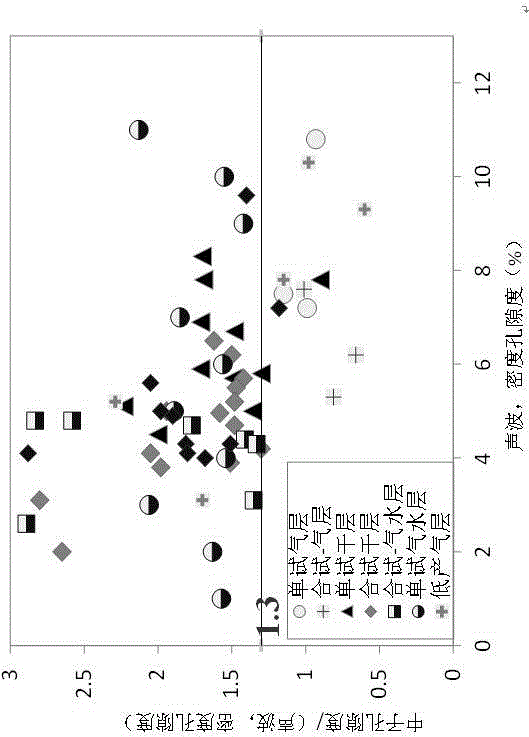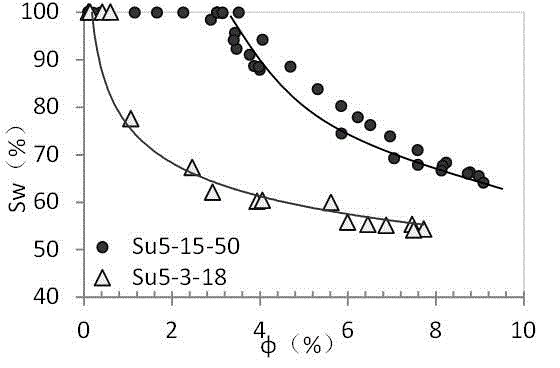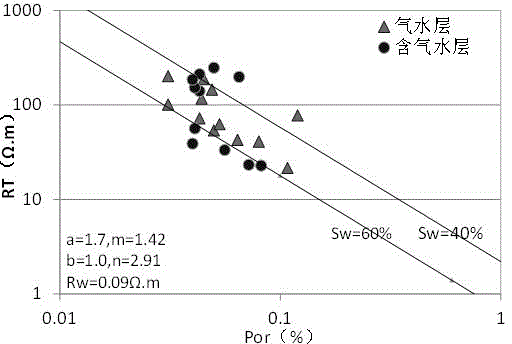Method for identifying fluid type of reservoir with complicated pore structure by using conventional logging information
A technology with complex pore structure and conventional logging data, which can be used in earth-moving drilling, wellbore/well components, etc. It can solve problems such as inapplicability and inability to solve, and achieve the effect of reducing investment and improving exploration effect.
- Summary
- Abstract
- Description
- Claims
- Application Information
AI Technical Summary
Problems solved by technology
Method used
Image
Examples
Embodiment 1
[0029] As the most basic embodiment of the present invention, it is based on Figure 5 The process of operation can complete the technology of using conventional logging data to identify the reservoir fluid type with complex pore structure. The specific method is as follows:
[0030] Step 1: Distinguish air layers and non-air layers (water layer, air-water layer and dry layer) according to the neutron porosity / acoustic (density) ratio.
[0031] Step 2: For non-gas reservoirs, the pore-saturation intersection method is preferred to distinguish effective reservoirs from ineffective reservoirs;
[0032] Step 3: For the effective reservoir, the gas-water layer and the water layer are further distinguished by using the combination of hole-electric intersecting and gas layer mud logging.
Embodiment 2
[0034] As the best implementation mode of the present invention, its application in the method for this kind of reservoir type discrimination represented by the Majiagou Formation is as follows:
[0035] first step: figure 1 It is the neutron porosity / acoustic (density) and acoustic (density) intersection diagram of all gas-test intervals in the Majiagou Formation, from figure 1 It can be seen from the figure that the neutron porosity / acoustic (density) porosity value of wells tested for gas layers is generally less than 1.3; while the values tested for gas-water layers, water layers and dry layers are generally greater than 1.3. For the high-porosity dry layer, it is only the high-reduced water layer that does not produce movable water, which is why the value of the high-porosity dry layer or the low-yield layer (including the low-gas-yield layer) is also greater than 1.3.
[0036] In the second step, for non-gas layers with neutron porosity / acoustic (density) porosity val...
PUM
 Login to View More
Login to View More Abstract
Description
Claims
Application Information
 Login to View More
Login to View More - R&D
- Intellectual Property
- Life Sciences
- Materials
- Tech Scout
- Unparalleled Data Quality
- Higher Quality Content
- 60% Fewer Hallucinations
Browse by: Latest US Patents, China's latest patents, Technical Efficacy Thesaurus, Application Domain, Technology Topic, Popular Technical Reports.
© 2025 PatSnap. All rights reserved.Legal|Privacy policy|Modern Slavery Act Transparency Statement|Sitemap|About US| Contact US: help@patsnap.com



